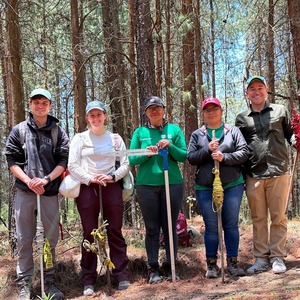
Supporting Community-Led Conservation Science and Policy Needed to Protect Critical Biodiversity and Ecosystem Services
Research Location:
Implemented: Milpa Alta Borough, Mexico City, Mexico
Conservation Partner:
Biological Monitoring Group of Milpa Alta, Universidad Nacional Autónoma de México (UNAM), and the Universidad Autónoma del Estado de México (UAEMéx)
Student Researcher (2024)
Evelyn Hall, Major: Integrative Conservation; Major (self-designed): Ecological & Spatial DataStudent Researcher (2024)
Cathryn Little, Major: Biology; Major: Integrative ConservationStudent Researcher (2023)
Sam Dutilly, Major: Biology; Major: Environmental Science
Student Researcher (2023)
Emma Lankford, Major: Integrative Conservation; Major: BiologyStudent Researcher (2022)
Bibiana Mirones ‘22, Major: Gender, Sexuality, and Women’s Studies; Major: Environmental PolicyStudent Researcher (2022)
Jordan Bryant '23, Major: BiologyFaculty Mentor
Dr. Fernando Galeana Rodriguez, Dr. Martha Case and Dr. Sapana Lohani
Project Description
In collaboration with the Biological Monitoring Group of Milpa Alta, W&M students are working with faculty from W&M and Mexican Universities to develop a methodology to support community-led monitoring and conservation of forest and grassland ecosystems in Mexico City’s Milpa Alta Borough. This project serves as a model for how collaborative teams can develop tools that support community-led conservation initiatives.
Indigenous Peoples and local communities play a critical role in the protection of the world's biodiversity and natural resources, yet they are often not included or empowered in conservation policy and management. The Biological Monitoring Group of Milpa Alta is demonstrating how citizen science can be used as a tool to implement community-led conservation initiatives and to strengthen community advocacy for the right to manage their ecosystems to promote conservation and their community.
This project serves as a model for community-led conservation and an opportunity to explore tools to support community-led conservation initiatives. The conifer forests and native grasslands covering the volcanoes and mountains surrounding Mexico City provide a habitat for endangered endemic species and invaluable ecosystem services for one of the world’s largest metropolises. These mountains catch about 70% of the water consumed by 22 million people. Massive reforestation campaigns geared toward protecting the forest have degraded the environment, replacing diverse ecosystems with green deserts dominated by high-density monocultures. This green expanse, encompassing wetlands, forests, and diverse ecosystems, not only harbors ecological significance but also furnishes vital environmental amenities to the city—from recharging aquifers to air purification.
Since 1998, local communities in Milpa Alta have been at the forefront of pioneering environmental services programs. Their flagship initiative was the formation of forestry brigades, undertaking critical roles in reforestation and fire prevention. While these brigades have invigorated local organizational capacities and boosted incomes, the very reforestation they championed inadvertently spawned 'green deserts' - monocultural expanses that disrupted natural tree habitats in open grasslands.
The Biological Monitoring Group of Milpa Alta, created in 2014, pivoted to address this challenge, introducing innovative forestry practices to reclaim these landscapes. The Institute of Integrative Conservation (IIC) has been partnering with the Monitoring Group since 2022 to develop a citizen science project that would help them measure the impact of their management practices. In 2023, W&M students developed a protocol for transect monitoring of selected sites and compiled a list of native species for the development of a field guide.
In 2024, Evelyn Hall '25 and Rynn Little '25 will use GIS and remote sensing technology and field vegetation surveys to make a detailed land cover and land use map of Milpa Alta that will support the Monitoring group with their restoration efforts and monitoring.
Project ID - Format
22-014-22 - CRP Year
22-014-23 - CRP Year
22-014-24 - CRP Year














